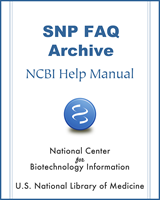The updated ftp directory is organized as follows:
The main ftp directory for dbSNP contains a number of directories, the most useful of which are:
The organization of each of the above directories is explained below:
The FTP “organisms/” directory:
The FTP “organisms/” directory contains a list of the organisms for which we have SNP data, organized by common name, and followed by its NCBI taxonomy id number. For example, the organism “Homo sapiens” is listed as “human_9606”.
Click on the organism of choice to access the ftp report files available for it. For example, if you click on human_9606 from the list of organisms, you will find that the human organism subdirectory contains the following files:
ASN1_bin/
ASN1_flat/
XML/
chr_rpts/
rs_fasta/
submit_format/
genotype_by_gene/
genotype/
haplotypes/
database/
misc/
Please note that the “database/” subdirectory within a species directory (see above list) contains the following files or links to files:
View in own window
organism_data
This subdirectory contains the species .bcp files for many tables, including: “Batch”, “dn_table_rowcount”, “RsMergeArch”, and “SNPAncestralAllele”.
organism_shared_data link
This link takes the user to the organism_shared_data subdirectory, which contains tables of .bcp data shared among organisms.
schema |
The FTP “database/” directory:
The FTP “database/” directory contains the following subdirectories:
View in own window
organism_shared_data
This subdirectory contains tables of .bcp data shared among Organisms, and includes the “Allele.bcp” file
schema
This subdirectory contains the schema of dbSNP_main, which contains tables shared among organisms.
Illumina_top_bot_strand_note
This document defines the “top” and “bottom” strands of a sequence in the absence of a reference genome to orient submissions.
b124
This subdirectory contains all the old database related files as of build 124. |
The FTP “specs/” directory:
The FTP “specs/” directory contains a number of text, .pdf, .asn, and .xsd files on everything from dbSNP submission instructions, and b125 mapping information to genotype resource information and haplotype submission .xsd files. (12/9/05)

